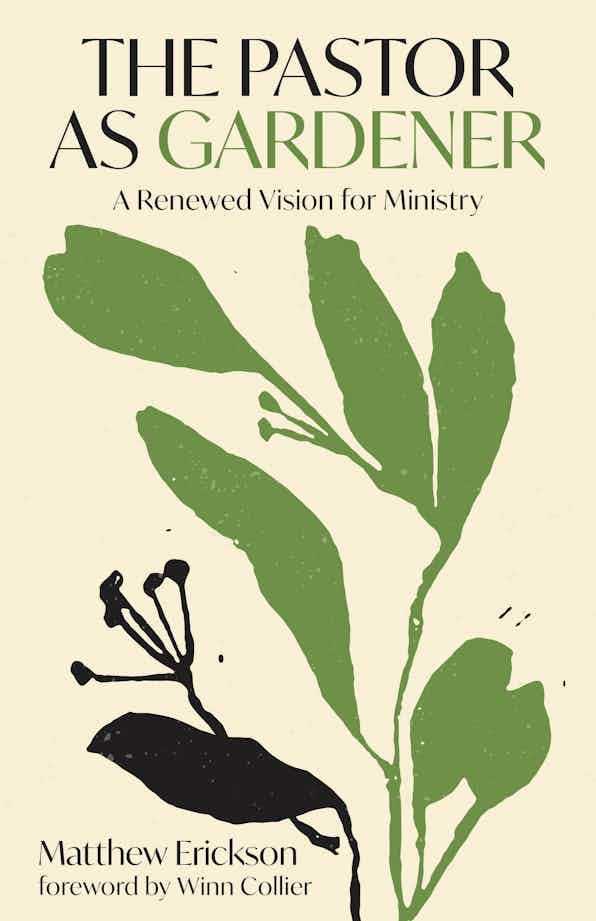A PASTOR, WRITER, AND SPEAKER SEEKING TO LEAD PEOPLE INTO THE TRANSFORMING PRESENCE OF THE TRIUNE GOD.
“I believe that fruitful ministry arises from the overflow of our life with God.”

pastor || writer || speaker
A PASTOR, WRITER, AND SPEAKER SEEKING TO LEAD PEOPLE INTO THE TRANSFORMING PRESENCE OF THE TRIUNE GOD.
“I believe that fruitful ministry arises from the overflow of our life with God.”
Matt’s book, The Pastor as Gardener: A Renewed Vision for Ministry, will be published with Eerdmans Publishing in March 2026 and is available for preorder now here.
When you pre-order the book (or if you already have pre-ordered it), sign up here to receive the following complimentary resources: an advanced digital copy of the book, pastoral ministry reflections resource, and a discussion guide for the book.

In times of confusion and chaos, people often find that their path to wholeness runs through a garden. Tending plants and tilling soil are timeless, restorative acts that can renew our sense of identity and purpose. In The Pastor as Gardener, Matthew Erickson taps into this truth and applies it to the work of pastoral ministry.
Writing for clergy who question whether meaningful ministry is possible in our current cultural context, Erickson encourages pastors to reframe their vocation as the work of a gardener. Bringing together Scripture and practical theology, he shows how gardening metaphors offer new ways of thinking about critical issues in pastoral work: effectiveness, humility, hospitality, and more. Readers will come away with a deeper appreciation for their ministry environment, a better understanding of the stages of growth in the pastoral life, and an increased ability to persevere in ministry even when fruit is not immediately apparent.
Nuanced and insightful, The Pastor as Gardener will appeal to readers who appreciate the pastoral wisdom of Eugene Peterson and the agrarian sensibilities of Wendell Berry. For ministers seeking a sense of vocation that is deeply rooted but also dynamic, this book is essential reading.
“We kneel with our hands in the soil of pastoral ministry, finding connection with those who have done this work before us and those who will do it after we are gone. We learn from Jesus, who is simultaneously the seed, the vine, and the gardener.”
Matt speaks regularly at Eastbrook Church, where he serves as the Senior Pastor. You can access those messages in audio and video format via the Eastbrook app, through the Eastbrook Vimeo channel or by subscribing to the Eastbrook audio podcast.
January 2026 – Eastbrook Church Student Ministry Winter Retreat (McNaughton, WI)
March 22, 2026, 1 PM – Pastor as Gardener book launch event at Eastbrook Church (Milwaukee, WI)
March 25, 2026, 12 PM – Pastor as Gardener book launch event at Upper House (Madison, WI)
June 27-July 3, 2026 – Family Camp 2 – Fort Wilderness (McNaughton, WI)
2025
November 19 – Brookfield Christian School Middle School Chapel
June 14-20 – Family Camp 1 – Fort Wilderness (McNaughton, WI)
June 14 – Staff Summer Study – Fort Wilderness (McNaughton, WI)
March 5 – “The Soil of Ministry” – Embassy Center MKE with North Central University students (Milwaukee, WI)
February 1 – “Freely Forgiven, Free to Forgive” – No Regrets Men’s Conference (Brookfield, WI)
2024
July 13-19 – Family Camp 5 – Fort Wilderness (McNaughton, WI)
July 13 – Staff Summer Study – Fort Wilderness (McNaughton, WI)
May 9 – God the Gardener – Kinship Community Food Center (Milwaukee, WI)
2023
November 6-8 – Pastors Conference with Good News International (Kigali, Rwanda)
October 20-21 – “Everyday Christianity in Our Personal Lives” – Eastbrook Church Men’s Retreat (Lake Geneva, WI)
September 4 – Consortio Dei podcast with John Chandler
August 17 – Eastbrook Academy Teachers Retreat – Salvation Army Camp Wonderland (Racine, WI)
April 25 – “Spiritual Health in Ministry” – Elmbrook Church Staff Meeting (Brookfield, WI)
April 19 – Middle School Chapel at Brookfield Christian School (Brookfield, WI)
March 29-31 – with Kelly Erickson – Fort Wilderness Staff Retreat
March 4 – Men’s Breakfast at Eastbrook Church (Milwaukee, WI)
January 27-29 – “A New Life” – Eastbrook Church Student Ministry Winter Retreat (Fort Wilderness, McNaughton, WI)
“Preaching Difficult Passages: Habakkuk” in Preaching Today
“Casting Pictures into the Imagination” in Preaching Today
“Toward a Theology of Seeing”; contribution for exhibit booklet for Asher Imtiaz, “God at ‘I’ Level,” for Doxology 2025 (October 2025).
“Preaching through Anxiety” in Preaching Today (October 2024).
“Renewed Freedom in Christ“: a review of Eugene H. Peterson’s Traveling Light: Galatians and the Free Life in Christ, Expanded edition, in The Living Church (May 2024).
“Let the Message Live in You” in Preaching Today (February 2024).
“Preaching Like Jazz” in Preaching Today (January 2024).
“Light of the World” – a Christmas sermon in Preaching Today (November 2023).
“Born to Save” – a Christmas sermon in Preaching Today (November 2023).
“Hope for a Weary World” – a Christmas sermon in Preaching Today (November 2023).
“Glory to the Newborn King” – a Christmas sermon in Preaching Today (October 2023).
“Spiritually Formed Preachers” in Preaching Today (October 2023).
“Coming Back to Life – a review of Andy Crouch’s The Life We’re Looking For: Reclaiming Relationship in a Technological World” in The Living Church (October 2022).
“Peterson as Your Pastor – a review of Eugene H. Peterson’s On Living Well: Brief Reflections on Wisdom for Walking in the Way of Jesus” in The Living Church (March 2022).
“Finding Our Way Back with Christ: Four Pathways for Preaching in Lent” in Preaching Today (February 2022).
“Metaphors for Ministry: Hitting The Road with Cormac McCarthy” in Preaching Today (January 2022).
“Prayer in the Three Seasons of Our Sermon” in Praying for Your Sermon at Preaching Today (June 2021).
Bible Book preaching guides by Preaching Today: “Preaching on Habakkuk,” “Preaching on Galatians,” and “Preaching on Ephesians” (April 2021).